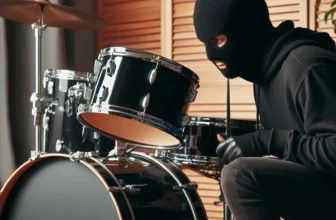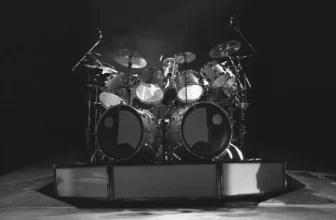The Bo-Diddley Beat: Origins, and How to Play It!


Bo-Diddley is a type of syncopated beat that you can hear almost everywhere. It’s like that phenomenon where, once you see the arrow in Amazon’s logo, you can’t unthink the phrase “A to Z!”
The Bo-Diddley beat was first created in the 1950s, but the syncopated rhythm has much older roots (more on that later). Every time I go to write a new little something, I’m tempted to use the iconic” Clap Clap Clap Clap-Clap!”
What Does the Bo-Diddley Beat Sound Like?
The Bo-Diddley beat is a two-bar rhythm that is highly catchy and iconic. Even though it is most often associated with older rock music, it reminds me of exotic world hand percussion. You can hear the Bo-Diddley beat in everything from pop songs to electronic, blues, jazz, and more. If I had to put it into words, it sounds groovy and danceable.
You can listen to an example of the contagious beat here (and listen to how wild the ladies went for it, even in 1965!).
Bo Diddley, the Father of Rock’ n Roll
Bo Diddley (Ellas Otha Bates) was born in 1928 in Mississippi and was a guitarist/musician and songwriter. The bo-diddley beat was named after Mr. Bo Diddley. He was considered a very early rock and roll musician, although his music doesn’t sound like rock to modern ears. Diddley aided in the transition from the era of blues to the era of rock.
Bo Diddley even wrote a song named ‘Bo Diddley‘ with his beat in it. Wow, is that a lot of Bo-diddley-ing (Yep, it’s even a verb now, too!). ‘Bo Diddly’ was performed in acts like The Ed Sullivan Show and ranked high in the blues charts at the time.

Diddley was much more than the creator of a famous beat, though. He was also an inventor, guitarist, and Grammy award winner. He created his own custom square guitar, which had a unique sound. This instrument was made from a cigar box, like old guitars. He found a way to make his cigar box an electric guitar by using parts from an old record player.
Bo Diddley was inducted into the Rock & Roll Hall of Fame in the late 1980s. His musical genius inspired musicians like Elvis, Buddy Holly, The Beatles, and other rockers.
Where Did Bo Diddley Get His Name?
We don’t know where Bo Diddley got his name. According to National Blues Museum, there are two potential sources of the ‘diddley’ part. The phrase ‘diddley squat‘ meant nothing and was potentially an insult given to him by one of his friends. Others surmise that it comes from a diddley bow, a one-string dulcimer that was often given to children (National Blues Museum)
How Is the Bo-Diddley Beat Written?
The first bar is syncopated; the second beat comes in on the ‘and’ of two. The second measure is simply on the beat, on 2 and 3. While the second measure is a relatively straightforward rhythm, the entirety of the two-bar phrase almost makes it feel as if we weren’t playing in 4/4 at all.

That being said, I have seen the Bo-Diddley beat be condensed into a one-bar phrase. This way of writing looks much more intimidating than the 2-bar version. The beat can be placed differently in different instruments; here’s how it could look on snare and bass condensed into one bar. But no matter how you split it up, it makes for excellent accent practice.
Side note: I doubt that Bo Diddley gave much consideration as to how it’d look on the page, as the West African drumming that inspired him, as well as most Blues, were done by rote.
Clave Rhythms
The Bo Diddley beat has roots in something called 3-2 clave. In Afro-Cuban music, two wooden dowels (called claves) are often played in this 3-2 pattern. Bo Diddley cited that the rhythm he penned with was inspired by something called “Hambone.”
This example shows claves playing the Bo-Diddley beat/ 3-2 rhythm. Claves rhythms have created many must-know beats, such as the inverted 2-3 rhythm. My brain automatically analyzes the Bo Diddley beat as sounding exotic because these 3-2 and 2-3 clave patterns are integral to Latin music.
Clave rhythms can be categorized as ‘son’ or ‘rumba.’ The rumba clave beat has a slightly different placement of the last note in the syncopated bar. However, the son clave rhythm is the exact same beat as Bo Diddly’s. Bo is innovative because he took this Afro-Cuban/Latin beat and put it in the context of early rock. Berklee’s PULSE magazine has some great audio/visual examples of the two clave rhythms here.
Hambone
Hambone, or ‘Hamboning,’ comes from West Africa. Here we go with the banning of drums again. Hambone music was a percussive technique used by enslaved people. Their drums were taken away from them, so they began using the different parts of their body to create different timbres and sounds. Hambone later influenced blues, rock and roll music, and folk musicians from the South.
Here is an example of Hambone being performed in Tunisia.
You may also hear hambone referred to as Pattin’ Juba or Giouba, although these two are not the same. Hambone is a later iteration of West African Body percussion, whereas Pattin’ Juba was the original dance. It’s crazy how many musical elements we still see today come from ancient African concepts, such as how traditional African fertility dances turned into the Martinique/ a Bélé, which eventually transformed into jazz tap dance. What a pipeline! Anyways, back to the Bo-Diddley of it all.
How to Play the Bo-Diddley Beat
The Bo-Diddley beat is two bars long: the first bar has three beats, and the second has two beats. The three beats in the first bar are played over two, so they are technically triplets. The second bar is straightforward. On a drum kit, the Bo-Diddley beat is usually played on the floor tom and, sometimes, the bass drum.
If you are new to syncopated rhythms, playing the Bo-Diddley beat is easier to grasp by rote rather than by reading it. If you are playing on a drum kit, things are a bit more complicated. Usually, there are syncopated accents in the running line, which plays running eight notes, with one measuring feeling like this:
ONE e and A | two e AND a | three e AND a | FOUR e and a
For a more full sound, try Drum Magazine’s tutorial here. There are a few different ways you can dice it up. This drummer learned from Bo Diddley himself, so you know it’s a good one!
Depending on the setting, I’ve also seen this rhythm written for snare accents and higher toms.
What Instruments Play the Bo-Diddley Beat?
- Claves
- Toms
- Bass Drums
- Guitar
- And more!
Traditionally, the bo-diddley beat was played on toms or claves and often accompanied by shakers. But I’ve heard it in everything from low electronic bass lines to guitar strum patterns today. So check it out in the context of a guitar strum pattern here. Now that I’m listening to this on guitar, I realize that one of my dad’s signature riffs (affectionately titled “Dirty Rotten Potatoes” by his friends) uses the Bo-Diddley as well!
Songs with the Bo-Diddley Beat
- “I Want Candy” (The Strangeloves)
- “If It’s Lovin’ That You Want” (Rihanna)
- “Hateful” (The Clash)
- “Black Horse and the Cherry Tree,” “Suddenly I See” (KT Tunstall)
- “Who Do You Love” (The Rolling Stones)
“I Want Candy” by the Strangeloves, which Aaron Carter later redid, features the iconic beat in the drums and toms. Rihanna’s vibey, exotic R&B song also uses the beat, this time, shared between the snare and bass drum.
“Hateful” from The Clashes’ London Calling features a speedier example of the Bo-Diddley, and even adds in some of that traditional shaker.
British Singer-Songwriter KT Tunstall’s wildfire debut album Eyes to the Telescope has highly influenced blues/early rock and roll. The beat is a bit more subtle in “Suddenly I See” since there are so many percussive layers, but the Bo-Diddley “Black Horse in a Cherry Tree” is in your face! Listen to her thoughts on the album here.
Going a lot further back, The Rolling Stones’ “Who Do You Love” actually performed with Bo-Diddley himself live. Bo Diddley also opened for the Clash at one point, stating that it was ‘ridiculous.’ He’s also not a big fan of the Clash or honkin’ amplifiers. Click this link if you want a good laugh.
Bo-Diddley Beat: Conclusion
Bo Diddley’s influence on rock and roll is evident in the music of many famous artists. His unique sound and style are celebrated by music fans and rockers alike. Now that you know the Bo Diddley, take it and run with it!




